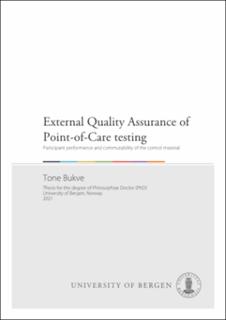| dc.description.abstract | The term point-of-care (POC) testing refers to laboratory tests performed near the patient, as opposed to a clinical laboratory setting. The aim of POC testing is to generate fast test results that facilitate accurate diagnosis and the initiation of proper treatment. POC testing is intended to improve patient outcomes and make laboratory testing available in settings where it has previously been unavailable. The measurement procedures (MPs) used for POC testing can be either simple test strips or complex analytical systems. In general, the MPs are more or less fully automated and often require few steps after sample collection before the test results are obtained. Since POC testing is usually performed outside the central laboratories, it is likely to be operated by persons who have not been trained as laboratory scientists, such as doctors, nurses, other healthcare professionals, or even the patients themselves.
POC testing is the fastest-growing part of laboratory testing and makes up a notable share of the in vitro diagnostic medical device market. While POC testing eliminates some of the more problematic steps in the testing process, such as transportation of samples and distribution of test results, new challenges are introduced. Specifically, concerns regarding the test quality of POC testing have emerged, however, they can be addressed through the quality management of POC testing. In Norway, users of POC testing participate in the Norwegian Organization for Quality Improvement of Laboratory Examinations (Noklus), which provides a quality management system, including external quality assurance (EQA), covering the total testing process.
Being a fundamental part of the EQA scheme, the EQA material must have characteristics that allow for evaluating the different MPs and their accuracy, precision, and calibration traceability, as well as provide a collective assessment of the laboratories, evaluating their reproducibility, standardization, and overall harmonization. The EQA material must possess a range of qualities to fulfill these requirements, the most important being commutability.
The aim of this thesis was to evaluate the effect of participating in an EQA organization and to evaluate the MPs and EQA material used to improve the participants’ analytical quality.
In papers I and II, the aim was to evaluate whether the analytical performance of POC testing was influenced by participation in a quality improvement system over time. The factors related to good participant performance were also addressed. The analytes included in the two studies were urine albumin (u-albumin), C-reactive protein (CRP), glucose, and hemoglobin (Hb). Results from EQA schemes at Noklus were assessed, 15 and 19 EQA schemes from 1998 to 2012 and 2006 to 2015, respectively. In paper II, logistic regression was performed to enable assessment of which characteristics predicted good participant performance. The average numbers of participants in the EQA schemes were 1159, 2134, 2357, and 2271 for u-albumin, CRP, glucose, and Hb, respectively. The results from the two studies showed a gradual increase in the percentage of participants with good performance. Furthermore, paper II showed that performing weekly internal quality control, performing the laboratory analysis ten or more times per week, using recommended MPs, and having operators that were qualified in laboratory medicine were all predictors of good participant performance in the EQAs.
In paper III, the aim was to assess whether Noklus’ in-house whole blood EQA material for CRP, glucose, and Hb was commutable for the most frequently used POC MPs in Norway and assess the possibility of using a common target value for each of the three analytes. The study was performed following the guideline of the Clinical and Laboratory Standards Institute, EP14-A3 evaluation of commutability of processed samples, 3rd edition. The EQA material was pooled stabilized EDTA venous whole blood containing different concentrations of CRP, glucose, and Hb. The EQA material and native routine patient samples were analyzed using 17 POC and 3 hospital MPs. Deming regression with 95% prediction intervals for each MP comparison was used for assessing commutability. The evaluation showed that the EQA material was commutable for all the CRP and Hb POC MPs and all glucose POC MPs at the lowest concentration (126.0 mg/dL (7.0 mmol/L)) and for the three glucose POC MPs at all concentrations.
In conclusion, the studies in this thesis have revealed that systematic participation in a quality management system for POC testing in primary healthcare can improve the analytical quality of u-albumin, CRP, Hb, and glucose measurements. The whole blood EQA material used was commutable for all CRP and Hb MPs, and for approximately half of the glucose MPs used in primary healthcare in Norway. Both participant and MP evaluations can now be performed for these participants and MPs. | en_US |
| dc.relation.haspart | Paper III: Bukve T, Sandberg S, Vie WS, Sølvik U, Christensen NG, Stavelin A. Commutability of a whole-blood external quality assurance material for point-of-care C- reactive protein, glucose, and hemoglobin testing. Clin Chem 2019;65:791-797. The article is available at: <a href="https://hdl.handle.net/1956/22830" target="blank">https://hdl.handle.net/1956/22830</a> | en_US |
